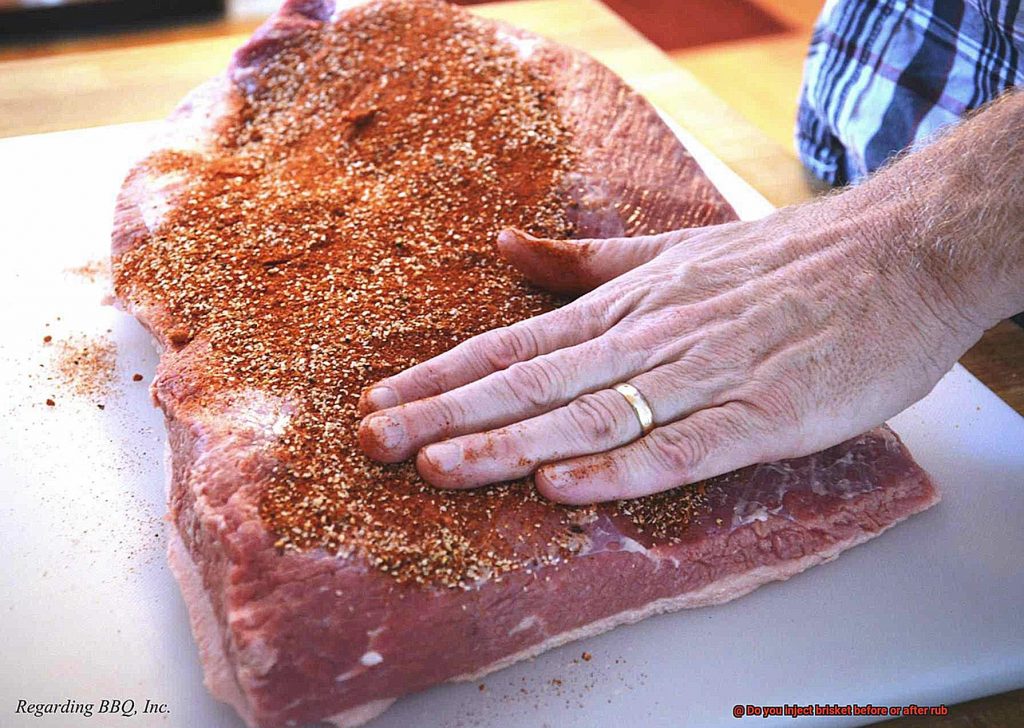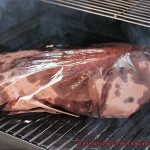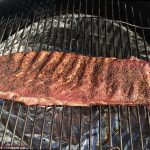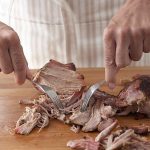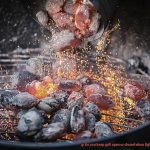Creating the perfect brisket is like conducting a symphony of flavors on your grill. It’s an art, and one technique that ignites fiery debates among grilling enthusiasts is whether to inject before or after applying the rub. Injecting infuses flavors directly into the meat, while rubs add an extra layer of tantalizing taste. Both methods can yield mouthwatering results, but understanding their pros and cons is key to achieving brisket nirvana, no matter your culinary prowess.
For us casual home cooks, injecting brisket before applying the rub has its perks. By injecting those flavorful juices right into the meat, you ensure that every bite explodes with deliciousness. Plus, injecting helps lock in moisture, leaving your brisket tender and juicy. It’s a lifesaver for those times when you’re short on marinating time but still crave intense flavors.
On the flip side, professional chefs often prefer rubbing before injecting their prized briskets. This sequence allows those spices and seasonings to dance with the injected flavors, resulting in a harmonious flavor fusion. And let’s not forget about that heavenly crust that forms on the surface of the meat thanks to the rub – it adds texture and makes your dish visually stunning. Perfect for competitions or when presentation matters as much as taste.
Ultimately, both methods have their merits; it all boils down to personal preference and desired outcome. But no matter what path you choose, nailing that perfect flavor and texture requires careful consideration of injection flavors and rub ingredients. Don’t be afraid to experiment with different combinations until you find that magical balance that suits your taste buds just right.
Injecting brisket before or after applying rub opens up a world of culinary possibilities – from infusing bold flavors directly into the meat to creating a symphony of injected and rubbed tastes. The end goal? A succulent, tender brisket that bursts with flavor. So whether you’re a casual home cook or a seasoned chef, understanding the advantages of each approach will guide you towards creating a brisket masterpiece that leaves everyone begging for seconds.
Contents
What is Injecting Brisket?
Injecting brisket is a technique used in barbecue and grilling to enhance the flavor and tenderness of the meat. It involves using a syringe or injector to inject liquid marinades, brines, or seasonings directly into the brisket before cooking. By injecting these liquids into the meat, the flavors are able to penetrate deep into the brisket, resulting in a more flavorful and juicy end product.
The process of injecting brisket starts by preparing a marinade or brine mixture. This can be a combination of various ingredients such as broth, spices, herbs, vinegar, fruit juices, or even beer. The choice of ingredients depends on personal preference and the desired flavor profile. Some popular flavors for injecting brisket include garlic, onion, Worcestershire sauce, soy sauce, and hot sauce.
Once the marinade or brine mixture is prepared, it is loaded into a syringe or injector. The injector typically has a needle with multiple holes to evenly distribute the liquid throughout the meat. The needle is inserted into different parts of the brisket, ensuring that the marinade reaches all areas of the meat. The injection should be done slowly and evenly to avoid excessive leakage or uneven distribution.
Injecting brisket offers several advantages. Firstly, it adds moisture to the meat, preventing it from drying out during the cooking process. This is especially important for brisket, which is a relatively tough cut of meat that can easily become dry if not cooked properly. The injected liquids help to keep the meat juicy and tender.
Secondly, injecting brisket allows for better flavor infusion. While applying rubs or seasonings on the surface of the meat can add flavor, injecting allows the flavors to penetrate deeper into the meat. This results in a more pronounced and well-rounded flavor throughout the entire brisket.
Furthermore, injecting brisket can also help to shorten the cooking time. The added moisture from the injected liquids helps to conduct heat more efficiently, allowing the brisket to cook faster. This can be particularly beneficial for larger cuts of brisket, as it reduces the risk of overcooking or drying out the meat.
It is worth noting that injecting brisket is not mandatory and personal preferences may vary. Some pitmasters prefer to only use rubs or seasonings on the surface of the meat and allow the flavors to develop during the cooking process. However, many barbecue enthusiasts swear by the benefits of injecting brisket and consider it an essential step in achieving a moist and flavorful end result.
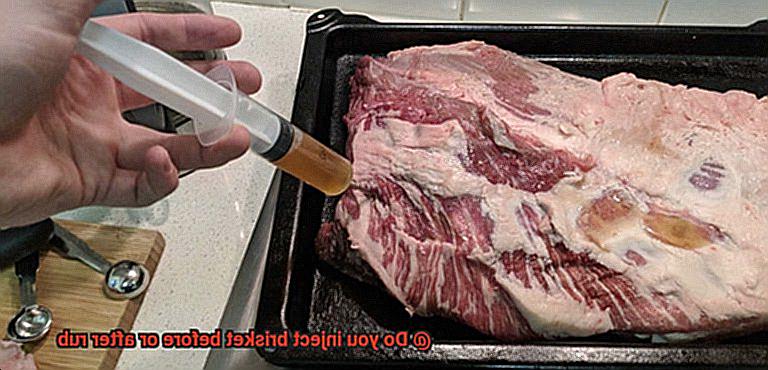
Benefits of Injecting Before Rubbing
Brace yourself for an explosion of flavor and tenderness that will leave your guests begging for more. Injecting your brisket with marinade before applying the rub is the secret weapon that will transform your barbecue game. Let’s dive into why injecting before rubbing is the ultimate technique for creating a mouthwatering masterpiece.
First and foremost, injecting the brisket with marinade enhances the flavor profile like nothing else. Picture this: savory spices, aromatic herbs, and tangy fruit juices seeping deep into every fiber of the meat, creating a symphony of taste that will make your taste buds dance with joy. The result? A brisket that is bursting with irresistible flavors in every bite.
But it doesn’t stop there. Injecting before rubbing also ensures that your brisket stays moist and juicy throughout the cooking process. As we all know, brisket is a lean cut of meat that can easily dry out on the grill. However, with the injection marinade acting as a natural brine, your brisket will stay succulent and tender, putting an end to those dreaded dry and tough slices.
Tough cuts of brisket can be a challenge, but injecting them with marinade works wonders in tenderizing the meat. The enzymes in the marinade break down those stubborn muscle fibers, resulting in a melt-in-your-mouth texture that will have your guests swooning with delight.
Time is of the essence, especially when unexpected guests show up for a backyard cookout. Injecting before rubbing saves you precious minutes by evenly distributing the flavors without the need for lengthy marinating sessions. It’s the perfect solution for those spontaneous grill-outs where every minute counts.
Injecting also allows for complete customization of flavors. Whether you want your brisket to have a spicy kick, a sweet sensation, or a tangy twist, you have full control over the ingredients in your injection marinade. Create a taste profile that suits your preferences perfectly and watch as your guests marvel at your culinary prowess.
And let’s not forget about the bark. The injection marinade not only enhances flavor but also contributes to the formation of a mouthwatering crust known as the bark. As the meat cooks, the injected flavors mingle with the natural juices and rub, creating a caramelized and irresistible outer layer that adds an extra dimension of deliciousness.
Benefits of Injecting After Rubbing
Injecting after rubbing has numerous benefits that can elevate the flavor and texture of a brisket. Let’s delve into each of these benefits in detail:
- Enhanced Flavors: When a rub is applied to the brisket first and allowed to sit, it creates a flavorful crust on the surface. Injecting the marinade after rubbing enables these flavors to penetrate deeper into the meat. The result is an explosion of taste in every bite.
- Moisture Retention: Injecting after rubbing helps the brisket retain moisture. The rub forms a protective barrier on the surface, preventing the marinade from escaping during cooking. This leads to a juicier and more flavorful end product that will leave your guests craving for more.
- Tenderizing Effect: The combination of the rub and injected marinade can tenderize the brisket. Through enzymatic action, the marinade breaks down tough muscle fibers, resulting in a tender and succulent texture. Each slice effortlessly glides through the meat, revealing perfectly juicy and melt-in-your-mouth goodness.
- Consistent Flavor Distribution: Injecting after rubbing ensures that flavors are evenly distributed throughout the brisket. The injection allows the marinade to reach areas that may not have been directly exposed to the rub, guaranteeing that every bite is infused with delectable flavors.
- Time-saving Technique: For those who prefer letting their rub sit on the meat for an extended period before cooking, injecting after rubbing can save time. By doing so, you can bypass the additional waiting time needed for the marinade to penetrate before applying heat.
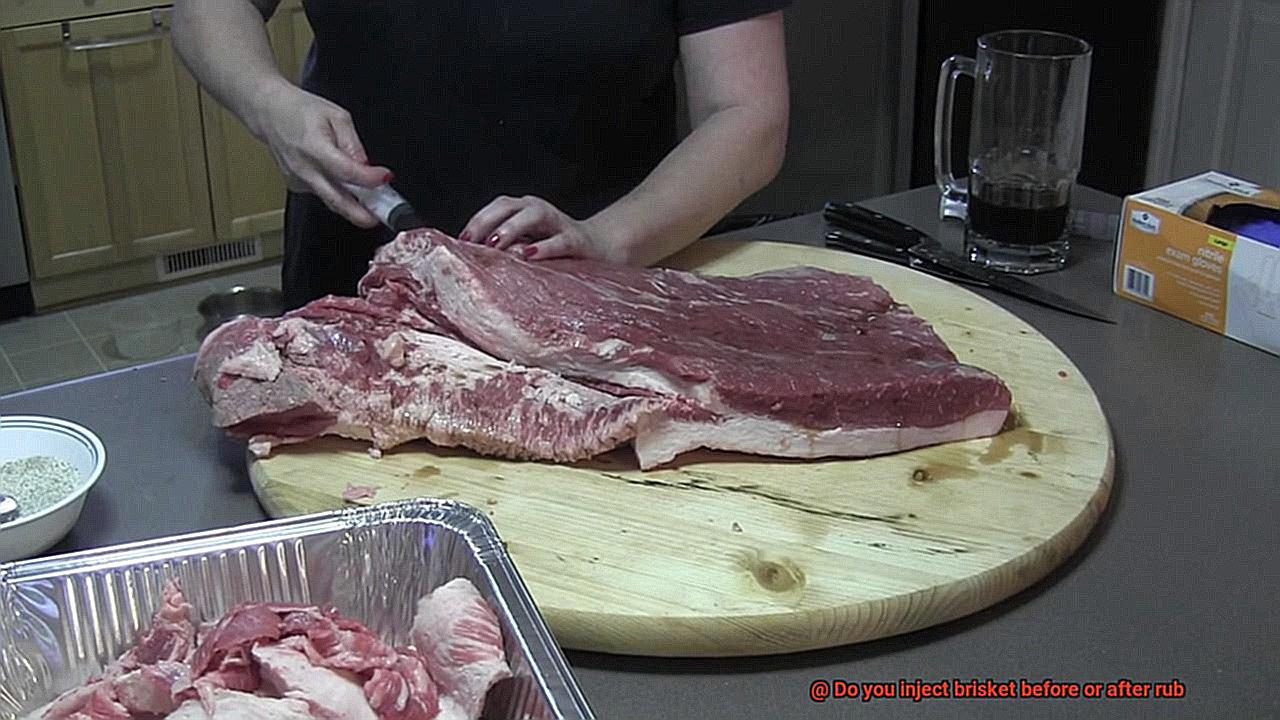
Factors to Consider When Deciding Whether to Inject Before or After Rubbing
Injecting before or after rubbing is a decision that requires careful consideration of several factors. The first factor to consider is flavor infusion. Injecting before rubbing allows the marinade to penetrate deep into the meat, resulting in a more pronounced and evenly distributed taste. This can create a flavor explosion throughout the brisket. On the other hand, injecting after rubbing creates a flavorful crust on the surface while still providing some infusion into the meat.
Texture and moisture are also important considerations. Injecting before rubbing helps retain moisture by adding liquid directly into the meat, resulting in a juicier final product. It can also contribute to tenderizing the meat. However, injecting after rubbing may lead to a drier exterior as some moisture may be drawn out during the cooking process.
Time constraints can influence your decision as well. Injecting before rubbing requires more preparation time as you need to allow the injected flavors to marinate and infuse into the meat before applying the rub. Injecting after rubbing allows for a quicker preparation process since you can immediately apply the rub after injecting.
The type of rub you are using is another factor to consider. Some rubs adhere better to dry surfaces, while others work best when applied to a moist surface. If you choose to inject before rubbing, make sure to pat dry the surface of the brisket before applying the rub to ensure proper adherence. Injecting after rubbing can help the rub stick to the meat more effectively.
Personal preference plays a significant role in this decision as well. Experimenting with different methods and flavors can help you determine which approach yields the best results according to your taste preferences.
Tips for Successful Injection and Rubbing
Injecting brisket before or after rubbing is a matter of personal preference and can vary depending on the desired outcome. Both methods have their advantages and can result in a delicious and flavorful brisket.
If you choose to inject the brisket before rubbing, it allows the flavors from the injection marinade to penetrate deep into the meat, resulting in a more pronounced and intense flavor. This method is often preferred by those who want a strong flavor profile and are looking for a bold and robust taste.
When injecting before rubbing, it is important to use a flavorful injection marinade that complements the rub you plan to use. The injection marinade should be well-balanced and not overpowering, as it will work in combination with the rub to enhance the overall flavor of the brisket.
It is recommended to inject the brisket at least a few hours before applying the rub to allow the flavors to meld together. This will give the meat ample time to absorb the injection marinade and develop a rich flavor profile.
On the other hand, some people prefer to apply the rub first and then inject the brisket. This method allows the rub to create a flavorful crust on the outside of the meat while the injection marinade adds moisture and flavor from within.
When using this method, it is important to apply a generous amount of rub to ensure even coverage and to create a flavorful bark on the brisket. The rub should be well-balanced with a blend of spices and herbs that complement the natural flavors of the meat.
Injecting after applying the rub can help prevent the injection marinade from diluting or washing away some of the rub’s flavors during cooking. This method is often preferred by those who want a well-seasoned crust on their brisket.
Regardless of whether you choose to inject before or after rubbing, it is crucial to properly prepare and handle the brisket. Make sure to trim any excess fat, pat the meat dry before applying the rub, and allow enough time for the flavors to meld together before cooking.
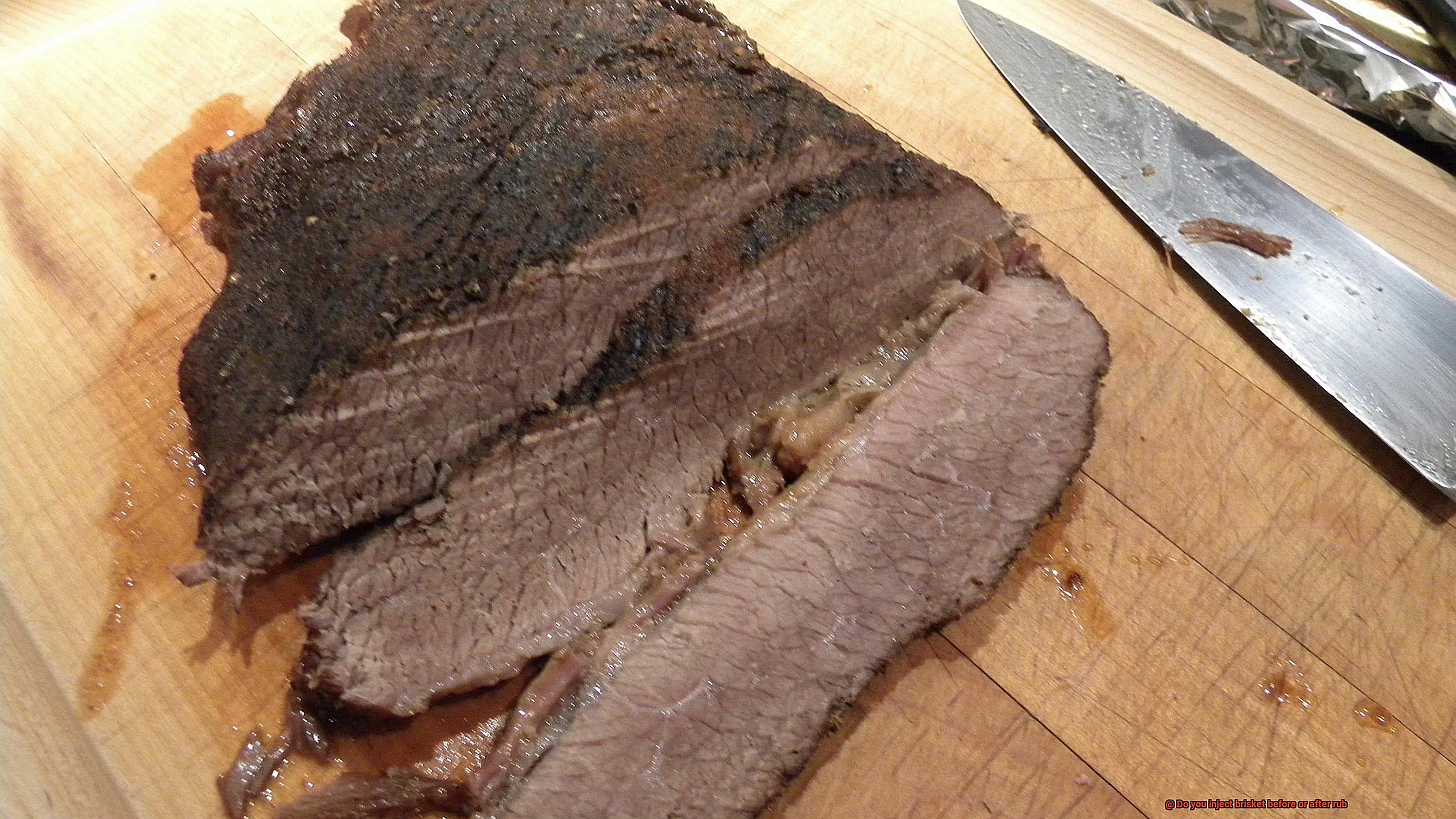
Experimentation is key when it comes to injecting and rubbing brisket. It is recommended to try both methods and see which one suits your taste preferences best. Remember to take notes on the results and adjustments made, as this will help you refine your technique and achieve consistent and delicious results.
Different Types of Injection Liquids and Rubs
Injection Liquids:
- Beef Broth-Based Injection: One popular injection liquid for brisket is a beef broth-based mixture. This injection adds a savory and rich flavor to the meat, enhancing its natural taste. The beef broth infuses the brisket with a deep and robust flavor, creating a mouthwatering experience with every bite. The richness of the broth complements the smoky flavors of the brisket, resulting in a harmonious and delicious combination.
- Apple Juice and Worcestershire Sauce: Another common option is a combination of apple juice and Worcestershire sauce. This injection provides a sweet and tangy taste that complements the brisket perfectly. The apple juice adds a subtle sweetness to the meat, while the Worcestershire sauce adds a tangy and savory kick. The combination of these two flavors creates a well-balanced and flavorful profile that enhances the overall taste of the brisket.
- Marinade or Brine: Some grillmasters prefer to use a marinade or brine as an injection liquid. This infuses the meat with additional flavors such as garlic, herbs, or spices, creating a more complex taste profile. The marinade or brine can be made with a variety of ingredients, allowing for endless possibilities and customization. Whether it’s a citrus-based marinade or a herb-infused brine, these liquids add depth and complexity to the flavor of the brisket.
Rubs:
- Dry Rubs: Dry rubs are mixtures of herbs, spices, and seasonings that are applied directly to the surface of the brisket. They add texture, color, and flavor to the meat. Popular ingredients in dry rubs include paprika, black pepper, garlic powder, onion powder, cayenne pepper, and brown sugar. The combination of these ingredients creates a robust and aromatic crust on the outside of the brisket, enhancing its visual appeal and taste. The dry rubs create a beautiful crust that locks in the moisture, resulting in a tender and flavorful brisket.
- Wet Rubs or Pastes: Wet rubs or pastes are similar to dry rubs but include additional ingredients like oil or mustard to create a paste-like consistency. These can be spread onto the brisket for added flavor and moisture. The wet rubs penetrate the meat, infusing it with a burst of flavors. The oil or mustard in the wet rubs helps to seal in the moisture, keeping the brisket juicy and tender throughout the cooking process. The combination of flavors and the moist texture created by the wet rubs make for a mouthwatering and satisfying brisket.
Timing:
- Injecting Before Rub: Injecting the brisket before applying the rub allows the flavors from the injection liquid to penetrate deep into the meat. This results in a more pronounced flavor throughout while keeping the brisket moist during cooking. The injection liquid seeps into every fiber of the meat, ensuring that each bite is infused with delicious flavors. The injected liquid also acts as a natural tenderizer, breaking down the connective tissues and resulting in a tender and succulent brisket.
- Injecting After Rub: Injecting the brisket after applying the rub allows for a concentrated flavor on the surface while still providing some moisture retention. This creates a flavorful and crusty bark on the outside of the brisket. The dry rub forms a flavorful crust that locks in the juices of the meat, resulting in a tender and juicy interior. The injection liquid adds an additional layer of flavor on top of this crust, creating a delicious contrast of textures and tastes.
Pros and Cons of Each Method
When it comes to grilling brisket, there are two popular methods to consider – injecting before applying the rub or applying the rub before injecting. Let’s explore the pros and cons of each method.
Injecting the brisket before applying the rub has several benefits. Firstly, it enhances the flavor of the meat. By injecting a marinade or flavorful liquid, you allow those delicious flavors to penetrate deep into the meat for a more intense flavor profile. This can take your brisket to a whole new level of deliciousness.
Additionally, injecting helps retain moisture during the cooking process. The liquid injected into the brisket acts as a barrier, preventing it from drying out and resulting in a juicy and tender final product. This is especially important as brisket can easily become dry if not cooked properly.
Another advantage of injecting before applying the rub is that it can lead to a faster cooking time. Since the flavors are already infused into the meat, you can achieve that tasty result in less time without compromising on taste. This can be particularly beneficial if you’re short on time but still want a flavorful and succulent brisket.
However, there are a few downsides to consider. Achieving an even distribution of flavors throughout the meat can be challenging when injecting. Some parts may end up being overly seasoned while others may lack flavor. It requires skill and practice to ensure an even distribution.
There is also a risk of over-marinating if the injection marinade is too strong or left in the meat for too long. This can overpower the natural flavor of the brisket and result in a less desirable taste. It’s important to find the right balance and be mindful of marinating times to avoid this pitfall.
On the other hand, applying the rub before injecting also has its advantages. It allows for better spice adherence, as applying the rub first helps the spices stick to the surface of the meat more effectively. This results in a more evenly seasoned bark, which adds an irresistible flavor and texture to your brisket.
Another benefit of applying the rub before injecting is that it offers better control over the flavor profile. You can adjust the amount of seasoning based on personal preference, avoiding overpowering or underwhelming flavors. This allows you to tailor the taste according to your liking.
However, there are a couple of potential drawbacks. Without injecting the brisket prior to applying the rub, there may be limited flavor penetration into the meat. This could result in a less intense flavor profile compared to injecting beforehand. It’s important to consider how bold you want the flavors to be in your brisket.
Additionally, applying the rub first may draw out moisture from the surface of the meat. This can lead to a slightly drier end product if not properly compensated for during the cooking process. It’s crucial to monitor and adjust cooking times and techniques accordingly to retain moisture and ensure a juicy brisket.
P2RnmNXGxxU” >
Conclusion
When it comes to injecting brisket, the question of whether to do it before or after applying rub is a hot topic among barbecue enthusiasts. Some argue that injecting before rubbing allows the flavors to penetrate deep into the meat, enhancing its taste from within. Others believe that injecting after rubbing helps the spices and seasonings adhere better to the surface, creating a flavorful crust.
To inject before or after rub? That is the burning question. Injecting before rub can be like adding fuel to the fire of flavor, as the marinade seeps into every nook and cranny of the brisket, infusing it with deliciousness. On the other hand, injecting after rub can be seen as a way to lock in those flavors and create a mouthwatering bark that will make your taste buds dance with joy.
So, which approach should you take? Well, it ultimately depends on your personal preference and desired outcome. If you’re looking for a tender and juicy brisket with flavors deeply infused throughout, injecting before rub might be your best bet. But if you’re aiming for a crispy exterior with bold flavors on the surface, then injecting after rub could be the way to go.
Regardless of your choice, one thing remains clear – injecting brisket is an art form that allows you to elevate its taste to new heights. So experiment, have fun, and let your palate guide you on this flavorful journey.
In conclusion, whether you inject brisket before or after applying rub is a matter of personal preference and desired outcome. Both approaches have their merits and can result in deliciously satisfying results.

